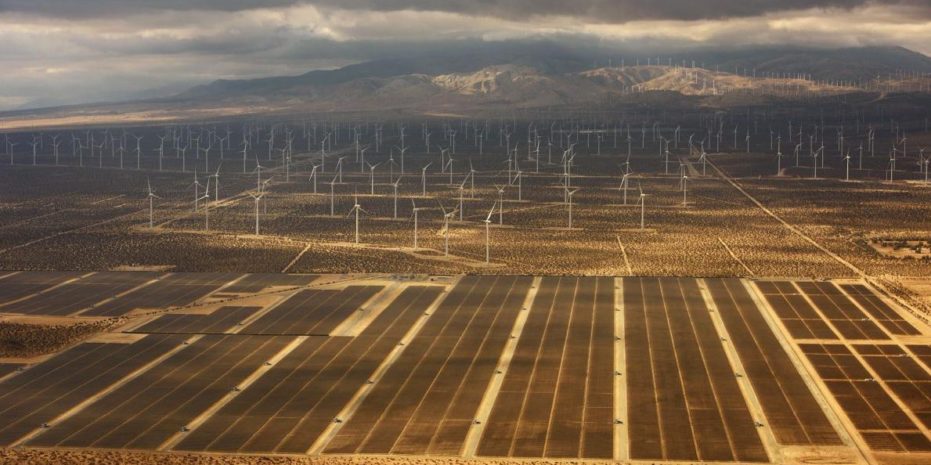Wind + solar + 12 hours of energy storage can get us to 80% of the United State’s electricity usage – without extensive nationwide HVDC power line networks. In Texas, the ERCOT queue is even bigger than it was last summer, and with some of the cheapest night time electricity rates, it has a power grid begging for solar power. And with wind and solar electricity generation being quite complementary, this clean energy dream seems quite pragmatic.
Portland General Electric (PGE) and NextEra have announced plans to construct a 300 MW of wind, 50 MWac of solar power, and 30 MW / 120 MWh AC-coupled energy storage plant at the Wheatridge Renewable Energy Facility, located in Morrow County.

Prior to this announcement, the site had been developed for a 500 MW wind farm that NextEra bought the rights for in June of 2017. The project with a focus on wind can still be found on Oregon.gov, however, even there we see in November and December changes begin:
requests (of) approval to amend the site boundary from 13,097 to 14,624 acres; extend the construction commencement deadline from May 24, 2023 to December 31, 2023; and construct and operate the following: a 150 MW photovoltaic solar energy system; 41 distributed energy storage system sites
In the Supplemental Materials I and II (292 and page pdf) it notes that the solar systems will be composed of single-axis trackers within the “micrositing corridors” of the project. In the above image, the solar power inverters are the tiny red dots – the energy storage the blue dots within the orange solar border fences. Notice how they’re distributed among the solar in consistent patterns. These “micrositing” patterns very specifically chosen by very fine engineers for NextEra to maximize the production at the facilities.

The 41 distributed energy storage units were described as:
There will be approximately 41 sites of lithium‐ion batteries in concrete containers or similar containment. Each container will measure up to 12 feet wide, 36 feet long, and 10 feet tall. Lithium‐ion battery systems are modular systems. Each module contains multiple smaller battery cells, each measuring up to 3.2 by 7 centimeters. Modules are placed in anchored racks within the concrete containers; typically, each rack houses 12 battery modules along with a switchgear assembly.
It was in this document that there were 20 MW and 30 MW of energy storage power to be installed, as well 150 MW of solar power, however the final press release suggested the 50 MWac solar and 30 MW energy storage, so these layout documents will be edited. The document suggests a cost of approximately $7 million to decommission the 150 MW of solar power and energy storage.
PGE will own 100 megawatts of the wind project, expecting an investment of $160 million. A subsidiary of NextEra will own the balance of the project and sell its output to PGE under 30-year power purchase agreements.
The wind component of the facility will be operational by December 2020 and qualify for the federal production tax credit at the 100% level. Construction of the solar and battery components is planned to complete in 2021, though there was no 5% safe harbor start date mentions to note which year of the ITC the project would qualify for.
Portland General Electric released a consumer level video of the project:
This content is protected by copyright and may not be reused. If you want to cooperate with us and would like to reuse some of our content, please contact: editors@pv-magazine.com.








What does solar Wac mean? Or just Wac?
Watts AC is the solar inverter sizing. Paperwork didn’t note the dum of the solar modules – Watts DC.
The trend has been going out to bid for these large scale alternative energy generation projects. The results have been surprising for the bids coming back from the construction companies. XCEL in Colorado did this back at the end of 2016 and found several bids using solar PV or wind generation with energy storage cheaper to operate than the coal fired plants they are to replace. I believe due to the installation of the TESLA energy storage system installed across the Neoen Wind farm in Australia, the industry is focusing on Lithium Ion battery technology.
UTE Inc. is installing a large scale vanadium flow battery in China, it will be a 200MWh on demand generation resource for 4 hours and with the addition of more ion tank storage could be extended to generate 200MWh of electricity for a 24 hour period without having to be “recharged” by the grid. These wind farms and solar PV farms are large scale facilities. One can afford to install two football field sized ion tanks within the generation site’s perimeter. One could also break up the system into modules and have their own cell and ion tank storage for a block of solar PV panels or wind generation towers.